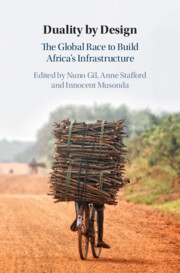Book contents
- Reviews
- Duality by Design
- Duality by Design
- Copyright page
- Contents
- Figures
- Tables
- Contributors
- Foreword
- Acknowledgements
- 1 Duality by Design: The Global Race to Build Africa’s Infrastructure
- Part I Mitigating Institutional Voids by Design
- 2 Why the Lights Went Out: A Capability Perspective on the Unintended Consequences of Sector Reform Processes
- 3 When the Quest for Electricity Reform and the Need for Investment Collide: South Africa, 1998–2004
- 4 Institutional Enablers of Energy System Transition: Lessons from Solar Photovoltaic Electricity in Eight African Countries
- 5 Harnessing Africa’s Energy Resources through Regional Infrastructure Projects
- 6 Centralized vs. Decentralized Generation in Zambia: Meeting Electricity Demand in the Context of Climate Change
- 7 Delivering Healthcare Infrastructure and Services through Public–Private Partnerships: The Lesotho Case
- 8 Achieving Long-Term Financial Sustainability in African Infrastructure Projects
- 9 A Proactive Social Infrastructure Model for Future Mixed-Use Housing in Egypt
- 10 Collective Action under the Shadow of Contractual Governance: The Case of a Participatory Approach to Upgrade Cairo’s ‘Garbage Cities’
- Part II Exploiting Institutional Voids by Design
- Afterword
- Index
- References
5 - Harnessing Africa’s Energy Resources through Regional Infrastructure Projects
from Part I - Mitigating Institutional Voids by Design
Published online by Cambridge University Press: 14 November 2019
- Reviews
- Duality by Design
- Duality by Design
- Copyright page
- Contents
- Figures
- Tables
- Contributors
- Foreword
- Acknowledgements
- 1 Duality by Design: The Global Race to Build Africa’s Infrastructure
- Part I Mitigating Institutional Voids by Design
- 2 Why the Lights Went Out: A Capability Perspective on the Unintended Consequences of Sector Reform Processes
- 3 When the Quest for Electricity Reform and the Need for Investment Collide: South Africa, 1998–2004
- 4 Institutional Enablers of Energy System Transition: Lessons from Solar Photovoltaic Electricity in Eight African Countries
- 5 Harnessing Africa’s Energy Resources through Regional Infrastructure Projects
- 6 Centralized vs. Decentralized Generation in Zambia: Meeting Electricity Demand in the Context of Climate Change
- 7 Delivering Healthcare Infrastructure and Services through Public–Private Partnerships: The Lesotho Case
- 8 Achieving Long-Term Financial Sustainability in African Infrastructure Projects
- 9 A Proactive Social Infrastructure Model for Future Mixed-Use Housing in Egypt
- 10 Collective Action under the Shadow of Contractual Governance: The Case of a Participatory Approach to Upgrade Cairo’s ‘Garbage Cities’
- Part II Exploiting Institutional Voids by Design
- Afterword
- Index
- References
Summary
Regional electricity systems, or power pools, can reduce the cost of providing electricity and improve system reliability through co-ordinated use of energy resources. Realizing these benefits requires a strong political will to co-operate combined with careful market design supported by technical, economic and institutional analysis. In this chapter, we present some of the unique motivations for power pools in Africa, describe the current status of pooling arrangements on the continent, study in detail the regulation of transmission in the Southern African Power Pool (SAPP) and identify some improvements to the present rules. Our approach combines mathematical modelling of the SAPP system using linear programming with analysis of regional institutions and their role in promoting efficient investments as well as efficient market behaviour. We have investigated several market-design questions, such as how to identify, implement and allocate costs for necessary regional transmission investments. Our regulatory proposals developed for the SAPP could be feasible options for other regional systems in Africa that face similar institutional and technical challenges in developing regional infrastructure.
- Type
- Chapter
- Information
- Duality by DesignThe Global Race to Build Africa's Infrastructure, pp. 130 - 160Publisher: Cambridge University PressPrint publication year: 2019
References
- 1
- Cited by

